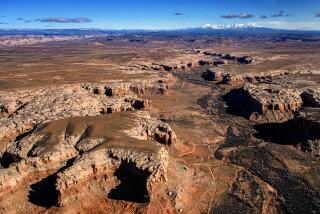COLUMN ONE THE WEST : Military Fights a Range War : Troop trainers feel fenced in by base closings and flak from Europe. Environmental fears are leaving them even less room to maneuver.
GLASGOW, Mont. — The prairie stretches across this isolated expanse of eastern Montana like a minimalist’s canvas. Brown and more brown, a million-acre monotone broken only by the clumps of sagebrush, the thin, thirsty grasses--and the deep tracks of military tanks.
Such jarring sights may soon become more familiar in some of the West’s most untamed lands.
Faced with recent base closures, stiff resistance toward large scale maneuvers in Western Europe, and increased training requirements with equipment that demands more room, the military is pushing to use up to 7.7-million acres of public land. The open spaces in Montana, Idaho, Utah and Nevada would be used for tank maneuvers, bombing runs, electronic combat zones and huge war games.
But the real battle-lines are only now being drawn between worried ranchers and dying towns, fishermen and fighter planes, backpackers and infantrymen, hunters and artillery, tanks and cows.
The fighting is certain to drag on for years, through public hearings, military tests and environmental studies.
“It’s getting more difficult to sell the sound of freedom,” said National Guard spokesman Maj. Everett Foster.
“But we do have to train somewhere.”
The expansion is part of a larger effort, recommended by the 1988 report of the defense secretary’s Base Closures Commission, to close 86 military bases, many in densely populated civilian centers, and move training into more open spaces where large-scale maneuvers can be practiced.
Military officials say the need for bigger training grounds is also fueled by equipment too technologically advanced to adequately test on most existing sites. Many tank ranges, for example, were originally designed for World War II-vintage vehicles that moved at 10 m.p.h. and had to stop to fire their guns. Today’s tanks can go 55 m.p.h., fire while moving and hit targets farther away.
Adding urgency to the search for open spaces is West Germany’s growing outcry against the noise and environmental damage caused by U.S. military maneuvers there. In the past year alone, large-scale exercises like the annual “Reforger” maneuvers in Germany have been scaled back dramatically, and low-level flying has been reduced to 15 minutes per flight for warplanes operating there.
The military argues that it can share land in the United States with grazers, hunters, recreationists, miners and even endangered species without serious damage.
“Tanks will actually enhance the soil because the tracks hold moisture,” said Col. George Donnelly, of the Montana National Guard, who said the state’s 5,000 troops currently must go out of state for much of the required 37 days of annual training.
Even then, Donnelly said, there are no available sites large enough for the troops to practice as an entire force.
“The maximum we can train at one time now is battalion-level,” he said. “That’s one-fourth of our brigade.
“It’s like having a baseball team where the catcher goes off to practice in one place, the pitcher goes off in another but never practices with the catcher, and the whole group is supposed to go to the World Series without ever practicing together.”
While the small, isolated communities near the proposed sites view the military expansion as their best and perhaps only chance at economic survival, opponents insist that an entire way of life is at stake.
“These areas--the rural, quiet areas of the West--are where quality of life is most esteemed,” said Bob Fulkerson, director of the Reno, Nev.-based environmental group Citizens Alert.
Some 400 people packed the junior high gymnasium in Glasgow recently to express concerns about a proposal by the Montana National Guard to build the country’s largest Guard training center on 981,000 acres of public land--one-third of all Valley County.
“They’re going to grind us into devastation!” an angry rancher shouted. “What they don’t grind up, they’re going to shoot up or bomb up.”
“Boy, I don’t like the looks of this,” said another. “You drive a motorcycle over the topsoil in this country and you got ruts for 10 years. What’s a 60-ton tank going to do?
“They want to play their military games, there’s hundreds of thousands of acres in Arizona they’ve got they already ruined. Let ‘em use that! There’s a hundred thousands acres in California they already ruined. Let ‘em use that!
“By God, I don’t want them to ruin Valley County!”
But others contend that Glasgow, the county seat, already is heading for ruin and only the influx of soldiers with money in their pockets can save it.
“The town is down to less than 4,000 people for the first time in 50 years,” said Payton Terry, who owns Glasgow’s only theater and favors the Guard proposal.
He ticks off the businesses that have closed--the sewing center, a service station, a convenience store, a lumberyard, the Radio Shack, three restaurants.
“In the past, being so isolated has been an albatross around our neck,” he said. “Now, cattle plus tanks equals jobs, prosperity and economic stimulation.”
Environmentalists, he charges, “would like to relegate the whole state to grazing buffalo.”
At the town hearing, only those opposed to the training center spoke up. Several ranchers later said merchants were afraid to say anything for fear of boycotts by the agricultural community.
More than 100 ranchers here have permits to graze some 26,000-31,000 cattle on the Bureau of Land Management acreage being eyed for the Montana Training Center, which would extend to the Canadian border 55 miles north.
Hunters stalk mule deer, sage grouse and antelope without having to worry about permit fees. Hikers look for rock arrangements called tepee rings, left by Indians before the homesteaders moved in.
An abandoned air base where B-17s once trained during World War II covers a small part of the proposed training site, which the Guard says could draw up to 3,600 troops, 1,200 vehicles and 40 attack planes and helicopters for 230 training days a year over a 30-year lifetime. Only 5,000 acres targeted for high explosives would be withdrawn from public use, which requires congressional approval. The BLM plans to make a decision on the rest of the proposal by December, 1991.
The BLM said it is also reviewing 10 other proposals for military use of public lands.
The largest would involve 1.3 million acres in southwestern Idaho, where the Air Force wants to expand a 100,000-acre bombing range to accommodate F-4 fighters being relocated with the closure of George Air Force Base near Victorville, Calif.
Other projects include a Nevada National Guard training center similar to the one proposed in Montana, on 600,000 acres near Hawthorne. The Navy also wants 75,000 acres to expand its “Top Gun” training at Fallon, and another 240,000 acres for an air range.
Also in California, the military wants to acquire 265,000 more acres to expand Ft. Irwin in the Mojave Desert.
The defense secretary’s Base Closures Commission said closing the other domestic bases could generate funds to lease lands between Ft. Irwin, the Marine Corps’ air-ground combat center at Twentynine Palms, Calif., and Nellis Air Force Base in Nevada. In Utah, the Air Force is looking at a highly sophisticated electronic combat zone with 80 targets scattered over about 4.5 million acres of desert west of Salt Lake City. The fenced-in targets themselves would cover only a few hundred acres, according to the Air Force, and the plan involves low-flying supersonic aircraft but no live ammunition.
But the Utah BLM says it has a “credibility problem” with the military after permitting massive National Guard maneuvers involving live fire on public lands a year ago.
Nearly $200,000 in damage resulted, said BLM spokesman Don Banks of the Salt Lake district, adding that the military paid the bill, helped with repairs and “they were genuinely remorseful.”
But “some things can’t be put back together,” Banks said, noting that one of two wildfires ignited by artillery shells burned down an entire winter hunting ground for bald eagles.
The BLM said dirt roads were torn up, a favorite undeveloped campground that was supposed to be off limits was used by 600 troops for nearly a month, and trees and vegetation were destroyed by the fires, weapons and heavy traffic.
In all, the Guard violated 35 of the 81 stipulations laid down by the BLM in the use permit.
“We saw some problems as they were occurring and we tried to do something to stop them but the exercise was so large and the authority so scattered that we couldn’t find anyone who would be accountable,” Banks said.
The current military expansion also includes proposals involving fewer than 10,000 acres in Washington state and Colorado.
“All of the sudden, bang! There’s all these military projects going on,” said Chuck Griffith, a National Wildlife Federation director whose region includes Montana, Utah and Idaho.
“We’re not talking an isolated military effort here and there,” he said. “There’s a real pattern popping up in these Western states and it’s too coincidental to be a coincidence.”
Spokesmen from various military agencies say there is no grand plan, merely a dire need for more training ground and air space to keep up with high-tech weaponry and ease away from heavy training in Europe.
In Montana, for example, the state Guard is getting an attack helicopter battalion, Donnelly said, but Utah is the nearest place to train on them.
Guardsmen must take time off from their regular jobs and pay their own travel expenses for their monthly weekend of training and annual two-week stints.
Donnelly said Guard pilots must qualify twice a year on F-16 guns, “but the closest place they can fire them is off the Oregon coast. The majority aren’t qualified because there’s no place to train.”
Training requirements for the National Guard as well as the Army Reserve have increased significantly over the past decade as the units became, in effect, major players instead of understudies in combat roles.
“The Guard was looked on in the past as the guys you called up in a hurricane,” said Foster. “We still build the ballparks and help out in floods, but we have an added task and we’ve got to be ready.
“We’re certainly not building training centers to build training centers.”
The Montana conflict is shaping up as a classic confrontation between technology and ecology, one being repeated throughout the country with various expansions of military training in places like Camp Grayling, Mich., and Deepwoods, Maine.
Diane Dirkson, secretary of the area grazing association in Valley County, scoffed at Guard assertions that tanks will tear up club moss and allow more grass to grow on the land.
“They may be able to reclaim it the first time, but that takes three to 10 years, and the Guard plans to be using it for 30 years,” she said. “It’ll never come back, and once the Guard leaves, nothing would be left of this town.
“The deer aren’t going to hang around to see what falls out of the sky and hits them,” she said, “and erosion from the tanks will muddy the streams and we’ll have fish kill-offs.
“The Guard says it would try to work out a financial compensation plan for the ranchers, but it’s their way of life being destroyed.
“They don’t want to sit there and just be paid to watch the dirt blow around.”
Staff writer Melissa Healy in Washington contributed to this story.
More to Read
Sign up for Essential California
The most important California stories and recommendations in your inbox every morning.
You may occasionally receive promotional content from the Los Angeles Times.










